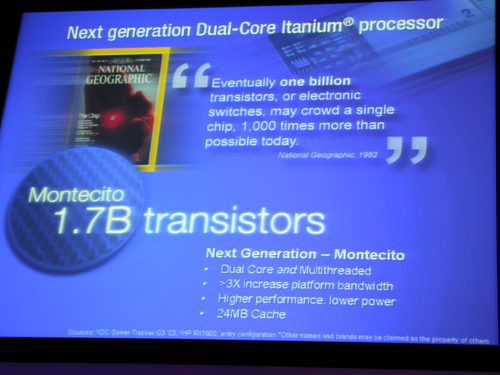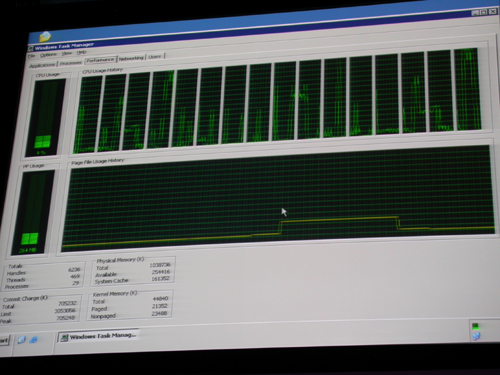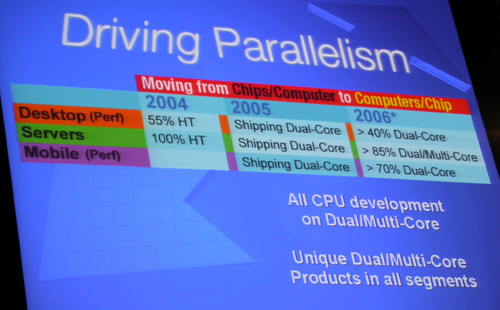
Original Link: https://www.anandtech.com/show/1465
Intel Developer Forum Fall 2004: Day 1 Keynote
by Derek Wilson on September 7, 2004 5:11 PM EST- Posted in
- Trade Shows
Introduction
We have been patiently waiting this Fall's Intel Developer Forum for quite some time. Rumors that Intel would host a live dual core demonstration have kept our interest piqued. It's tough to deal with that guilty kind of excitement, the kind where you hope for something you couldn't expect and the very hope itself seems to crush the chances of its fulfillment. After all the waiting, we can say that the rumors were true: Intel just finished demonstrating a running dual core Montecito Itanium processor. This is a good thing and a bad thing, but we'll talk more about that in a minute.
Amidst a few new things, we did hear plenty of the same old thing from Intel about technologies that are either here now, or years off into the future (with no new insight). For instance, much of the keynote covered Hyperthreading, EM64T, and Wifi, or focused on previously demonstrated technologies like Vanderpool. While all of these things are fun and interesting, we've already heard about them time and time again. Granted, the Vanderpool demo was from a business perspective rather than a home user perspective. It's cool to see 4 different hardware virtualized systems running on one computer, but the concept's potential and its uses have been explored previously via software such as VMWare. But buried in the presentation were a few tidbits we did find useful, and that's what where here to bring you today.
The following pages will cover the the new things mentioned at the opening keynote, as well as the growing importance Intel places on parallelism.
What's New From the Keynote
Digital Home
Streaming DTCP/IP video
In the digital home arena, one of the cornerstones of encouraging pervasive sharing of digital media is security. To this end, we have been hearing about Intel's DTCP/IP (Digital Transmission Content Protection over IP). This time around, Intel was able to demonstrate this technology delivering movies using RealNetworks streaming media. Part of the demonstration involved running two streaming movies using DTCP/IP on one computer (on two different televisions). Intel also stated that Microsoft would officially be supporting DTCP/IP in an upcoming version of Windows Media Center Edition. While we are always cautious about the privacy and fair use concerns that could come up with such content protection schemes, we absolutely hope that this will end up becoming an unobtrusive content protection scheme that will do nothing but encourage content providers to move to digital delivery systems.
iAMT for Manageability
Intel didn't elaborate a great deal on this topic. Apparently, iAMT (active management technology) is going to try to move management tasks into Silicon. Though very vague, we got the impression that iAMT would focus on identifying different types of problems and taking some kind of automated action to correct issues. Cutting down time a technician needs to deal with relatively simple problems could significantly help companies save money on computer support costs. We will try to find out more about iAMT if we can this week.
Back to the Future: Cache and Parallelism

cache fabbed on 65nm process technology
Its not surprising that with the shift of focus away from megahertz and toward parallelism, cache technology would gain more and more focus. If Intel is really going to start pushing multithreaded applications and parallel computer, lager cache sizes will be necessary to compensate for the increased number of processes that will want to have data stored on chip. As an extension of the EE line, it has seemed obvious that Intel would be brining a 2MB cache version of prescott P4s to the end user. Intel, today, confirmed the future of a 2MB cache P4, referred to as a Pentium 4 with a "performance oriented SKU." Much time was also spent talking about the Centrino line and other various technologies that incorporate higher parallelism. The most interesting of which was a demo of their dual core Itanium processor.
Pushing Parallelism

Finally, we have the demo we'd all been waiting for. Intel showed a 4p Itanium server running 4 dual core processors. This results in windows seeing 16 logical processors and reveals a crazy looking task manager window. The reason each dual core processor appears as four is that each core support Hyperthreading. Here's what ctrl+alt+del looks like with 4 parallel 1.7billion transistor dual core Itaniums:

The demo Intel ran on dual core processors was a very complex weather simulator.

While very cool, such a brief taste of the technology always leaves us wanting more. Unfortunately, Intel is being very tight lipped about their dual core endeavors in other areas. They have stated that dual core processors will be available in 2005, and that they expect some very high adoption rates to push dual core computing to 40% of desktops by 2006, and 85% of servers (which would be dual and multi core). They say the technology is also well suited to mobile devices, but we don't really have any more info than that. It is very clear that Intel will be targeting this area very aggressively as they expect the mobile market to be 70% dual core in 2006.

We were able to get a further lesson in parallelism in Intel's guests from NASA. The Space Administration is apparently working on a supercomputer using and sgi Itanium 2 server targeted at 60 Teraflops of power. This would put it at 50% more compute power than the worlds fastest supercomputer. The supercomputer project is called project Columbia and will feature 10000 processors when completed.
Now that Intel and AMD have both demonstrated dual core processors, it's only a matter of waiting for this technology to come down the pipe, into our labs, and into your homes. Here's to time flying.
We will do some digging while we're here, and hopefully someone will be able to help us discern a few more details about upcoming dual core technology and whatever else Intel may have up their sleeves. It's off to the show floor for now.







